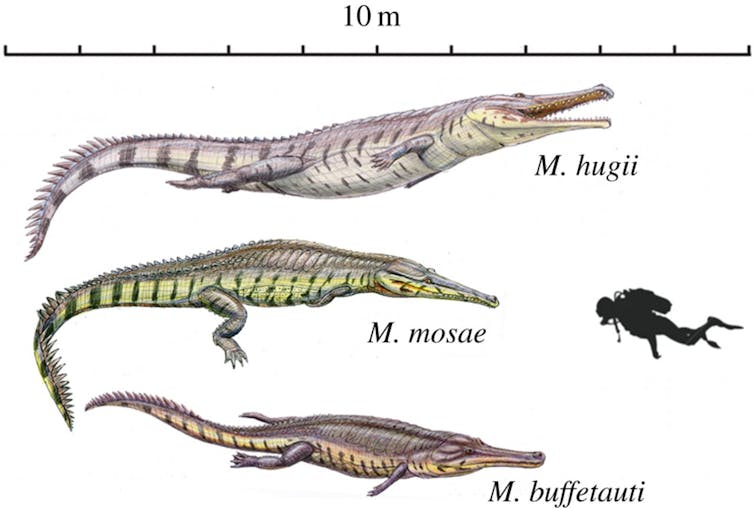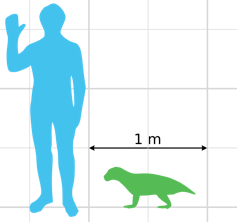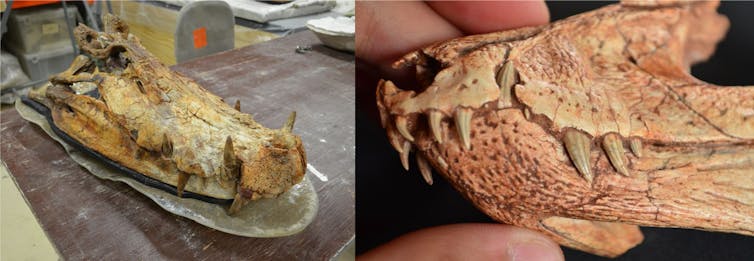Climate change created today's large crocodiles
- Written by Pedro L. Godoy, Postdoctoral Fellow in Anatomical Sciences, Stony Brook University (The State University of New York)
What does the term crocodylian bring to mind? A big reptile with a chomping jaw?
Crocodylians are the 27 species of crocodiles, alligators, caimans and gharials that live all over Earth today, except for in Europe and Antarctica[1]. There are some smaller species, but these top predators are usually big, at least 2 meters long. They also share a general shape and look – for instance, how easily can you tell an alligator and a crocodile apart[2]?
The fossil record of crocodylians is much richer, though, with many different forms and body sizes and extraordinary ecological diversity.
Over their long evolutionary history of more than 200 million years, crocs experimented with different lifestyles, as well as various body lengths. But exactly which environmental factors might have influenced the body sizes of crocs throughout their evolution? And does the body size of crocs suggest something about past species’ extinction?
To investigate, my colleagues and I created a complete map of body sizes of crocs[3] through time. Body size can reveal a lot about the biology of extinct animals. Our study was the first to apply some modern computational methods to understand body size evolution in crocs.
 Some ancient crocs were giants. See the human diver in this illustration for scale.
M.T. Young et al/Dmitry Bogdanov/Wikimedia Commons, CC BY[4][5]
Some ancient crocs were giants. See the human diver in this illustration for scale.
M.T. Young et al/Dmitry Bogdanov/Wikimedia Commons, CC BY[4][5]
Looking for size patterns in the fossil record
The Crocodylomorpha[6] group includes all extinct relatives of the modern crocodylians – more than 400 species in total.
 Compare a small herbivore croc called Simosuchus to the size of a modern human.
Smokeybjb/Wikimedia, CC BY-SA[7][8]
Compare a small herbivore croc called Simosuchus to the size of a modern human.
Smokeybjb/Wikimedia, CC BY-SA[7][8]
Extinct crocodylomorphs – henceforth “crocs” – ranged from marine forms[9] who lived a fully aquatic life to terrestrial herbivores[10] with complex teeth that look like those seen in mammals today. There’s much more ecological diversity on display in the fossil record than what you see in modern crocodylians.
The oldest crocs, alive during the Triassic Period[11], were small, rarely more than 1 meter long.
At first glance, the fossil record might seem to suggest that crocs evolved from this small start to be larger over time. That would fit with a general trend biologists have identifed: Animals tend to evolve over time to be bigger. This pattern is known as Cope’s rule[12]. Scientists have spotted this tendency in mammals[13], dinosaurs[14] and pterosaurs[15].
To see whether this rule holds for crocs, my collaborators and I pulled together data on almost 200 species, more than in any other croc body-size study.
Since paleontologists don’t know the exact size of most extinct animals, this kind of study frequently estimates body size based on a measurement of one part of the animal. In our case, we used skull length as a proxy for total body size.
We collected most of the data (for nearly 120 species) by measuring specimens during visits to museum collections around the world, from South America to China. The remaining information came from other researchers’ photographs or figures in the scientific literature.
 Left, a big Kaprosuchus skull in the paleontological collection at the University of Chicago. Right, a tiny Gondwanasuchus skull at the Paleontology Research Center, Peirópolis, Brazil.
Pedro L. Godoy, CC BY-ND[16]
Left, a big Kaprosuchus skull in the paleontological collection at the University of Chicago. Right, a tiny Gondwanasuchus skull at the Paleontology Research Center, Peirópolis, Brazil.
Pedro L. Godoy, CC BY-ND[16]
Factors that influence size
Our analyses show no evidence that crocs played by Cope’s rule: They don’t seem to have evolved to become bigger over time.
Instead, we saw a much more complex scenario, with multiple changes of average body size as various subgroups evolved and went extinct. Why?
One important clue appeared when we analyzed how body size changes across different lifestyles.
We divided crocs into three ecological categories: land-based, semi-aquatic and fully aquatic. We found that terrestrial crocs are significantly smaller than semi-aquatic and marine ones. Other researchers have documented similar findings for mammals, with marine species larger than their terrestrial relatives[17]. Think of walruses and sea lions, which are much bigger than their cousins: cats, wolves and dogs.
One explanation for this might be the adaptations that are necessary for life in the aquatic realm. For example, having a large body might help maintain an optimal temperature in the water[18].
We also investigated whether environmental factors – temperature and geographical distribution – had an influence on croc body size.
At first, we did our analyses with all 195 crocs and found no strong link between these factors and size. But when we subdivided the species into smaller subgroups, we found some interesting results.
One of these subgroups is Crocodylia, which includes modern crocodylians and only their closest extinct relatives. They lived mostly during the Cenozoic[19] – that’s our current era which began after the extinction of nonavian dinosaurs[20] 66 million years ago.
For Crocodylia, we found that larger sizes tend to be found with lower temperatures. This might seem counterintuitive, because crocs and other reptiles like warmer places[21]. But the way we interpreted this result is that, as the Earth got cooler, the areas crocs could live in got more restricted. This could have increased competition in their habitats and perhaps larger crocs were more successful. In the end, lower temperatures probably led smaller crocs to extinction.
A more nuanced picture of evolving size
There are two take-home messages from this discovery.
First, scale matters. When we analyzed all crocs together, we did not find significant correlations. But when we focused on a specific group (Crocodylia), at a shorter period of time (only the Cenozoic), we found interesting results.
The second is that climate change can shape the evolution of species. This is pretty obvious, and previous studies have shown it for other animals[22]. In the case of crocs, climate change – the cooling temperatures during the Cenozoic – probably contributed to the comparatively large sizes of today’s species. Crocs became more restricted to the tropics and this possibly led to the extinction of smaller species.
In the end, the large size of modern crocs, although a symbol of strength and power, might mean that this group is instead ecologically fragile, facing a long-term process of extinction. And today, the few croc species left are facing an extra challenge related to environmental changes, this time due to human-made destruction of their ecosystems[23].
[ Like what you’ve read? Want more? Sign up for The Conversation’s daily newsletter[24]. ]
References
- ^ Europe and Antarctica (www.nationalgeographic.org)
- ^ tell an alligator and a crocodile apart (www.livescience.com)
- ^ created a complete map of body sizes of crocs (doi.org)
- ^ M.T. Young et al/Dmitry Bogdanov/Wikimedia Commons (en.m.wikipedia.org)
- ^ CC BY (creativecommons.org)
- ^ Crocodylomorpha (ucmp.berkeley.edu)
- ^ Smokeybjb/Wikimedia (commons.wikimedia.org)
- ^ CC BY-SA (creativecommons.org)
- ^ marine forms (www.palaeontologyonline.com)
- ^ terrestrial herbivores (www.nationalgeographic.com)
- ^ Triassic Period (www.livescience.com)
- ^ Cope’s rule (theconversation.com)
- ^ mammals (science.sciencemag.org)
- ^ dinosaurs (onlinelibrary.wiley.com)
- ^ pterosaurs (www.nature.com)
- ^ CC BY-ND (creativecommons.org)
- ^ marine species larger than their terrestrial relatives (www.sciencemag.org)
- ^ maintain an optimal temperature in the water (www.eurekalert.org)
- ^ Cenozoic (www.livescience.com)
- ^ extinction of nonavian dinosaurs (www.nationalgeographic.com)
- ^ crocs and other reptiles like warmer places (www.gardinitiative.org)
- ^ previous studies have shown it for other animals (science.sciencemag.org)
- ^ human-made destruction of their ecosystems (www.theguardian.com)
- ^ Sign up for The Conversation’s daily newsletter (theconversation.com)
Authors: Pedro L. Godoy, Postdoctoral Fellow in Anatomical Sciences, Stony Brook University (The State University of New York)
Read more http://theconversation.com/climate-change-created-todays-large-crocodiles-121933


